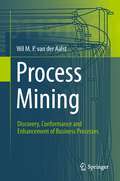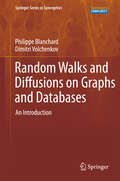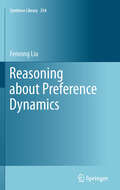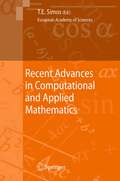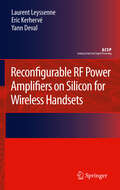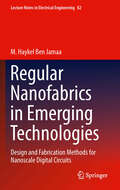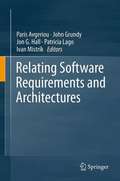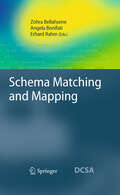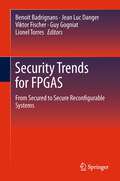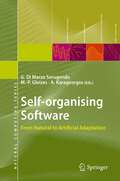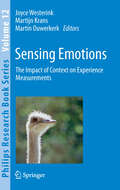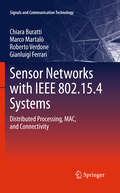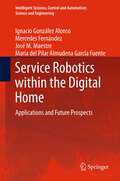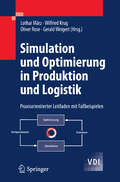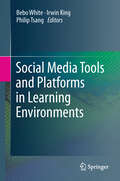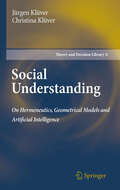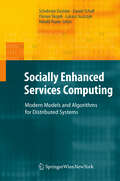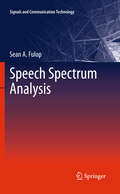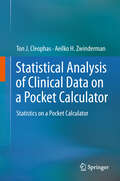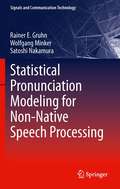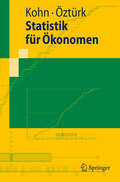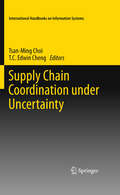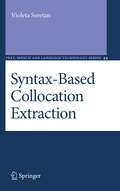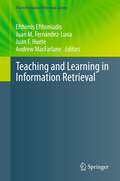- Table View
- List View
Process Mining
by Wil M. van der AalstThe first to cover this missing link between data mining and process modeling, this book provides real-world techniques for monitoring and analyzing processes in real time. It is a powerful new tool destined to play a key role in business process management.
Random Walks and Diffusions on Graphs and Databases
by Dimitri Volchenkov Philipp BlanchardMost networks and databases that humans have to deal with contain large, albeit finite number of units. Their structure, for maintaining functional consistency of the components, is essentially not random and calls for a precise quantitative description of relations between nodes (or data units) and all network components. This book is an introduction, for both graduate students and newcomers to the field, to the theory of graphs and random walks on such graphs. The methods based on random walks and diffusions for exploring the structure of finite connected graphs and databases are reviewed (Markov chain analysis). This provides the necessary basis for consistently discussing a number of applications such diverse as electric resistance networks, estimation of land prices, urban planning, linguistic databases, music, and gene expression regulatory networks.
Reasoning about Preference Dynamics
by Fenrong LiuOur preferences determine how we act and think, but exactly what the mechanics are and how they work is a central cause of concern in many disciplines. This book uses techniques from modern logics of information flow and action to develop a unified new theory of what preference is and how it changes. The theory emphasizes reasons for preference, as well as its entanglement with our beliefs. Moreover, the book provides dynamic logical systems which describe the explicit triggers driving preference change, including new information, suggestions, and commands. In sum, the book creates new bridges between many fields, from philosophy and computer science to economics, linguistics, and psychology. For the experienced scholar access to a large body of recent literature is provided and the novice gets a thorough introduction to the action and techniques of dynamic logic.
Recent Advances in Computational and Applied Mathematics
by Theodore E. SimosThis multi-author contributed proceedings volume contains recent advances in several areas of Computational and Applied Mathematics. Each review is written by well known leaders of Computational and Applied Mathematics. The book gives a comprehensive account of a variety of topics including - Efficient Global Methods for the Numerical Solution of Nonlinear Systems of Two point Boundary Value Problems; Advances on collocation based numerical methods for Ordinary Differential Equations and Volterra Integral Equations; Basic Methods for Computing Special Functions, Melt Spinning: Optimal Control and Stability Issues; Brief survey on the CP methods for the Schrödinger equation; Symplectic Partitioned Runge-Kutta methods for the numerical integration of periodic and oscillatory problems. Recent Advances in Computational and Applied Mathematics is aimed at advanced undergraduates and researchers who are working in these fast moving fields.
Reconfigurable RF Power Amplifiers on Silicon for Wireless Handsets
by Eric Kerhervé Laurent Leyssenne Yann DevalReconfigurable RF Power Amplifiers on Silicon for Wireless Handsets is intended to designers and researchers who have to tackle the efficiency/linearity trade-off in modern RF transmitters so as to extend their battery lifetime. High data rate 3G/4G standards feature broad channel bandwidths, high dynamic range and critical envelope variations which generally forces the power amplifier (PA) to operate in a low efficiency "backed-off" regime. Classic efficiency enhancement techniques such as Envelope Elimination and Restoration reveal to be little compliant with handset-dedicated PA implementation due to their channel-bandwidth-limited behavior and their increased die area consumption and/or bill-of-material. The architectural advances that are proposed in this book circumvent these issues since they put the stress on low die-area /low power-consumption control circuitry. The advantages of silicon over III/V technologies are highlighted by several analogue signal processing techniques that can be implemented on-chip with a power amplifier. System-level and transistor-level simulations are combined to illustrate the principles of the proposed power adaptive solutions. Measurement on BICMOS demonstrators allows validating the functionality of dynamic linearity/efficiency management. In Reconfigurable RF Power Amplifiers on Silicon for Wireless Handsets, PA designers will find a review of technologies, architectures and theoretical formalisms (Volterra series...) that are traditionally related to PA design. Specific issues that one encounters in power amplifiers (such as thermal / memory effects, stability, VSWR sensitivity...) and the way of overcoming them are also extensively considered throughout this book.
Regular Nanofabrics in Emerging Technologies
by M. Haykel Ben JamaaRegular Nanofabrics in Emerging Technologies gives a deep insight into both fabrication and design aspects of emerging semiconductor technologies, that represent potential candidates for the post-CMOS era. Its approach is unique, across different fields, and it offers a synergetic view for a public of different communities ranging from technologists, to circuit designers, and computer scientists. The book presents two technologies as potential candidates for future semiconductor devices and systems and it shows how fabrication issues can be addressed at the design level and vice versa. The reader either for academic or research purposes will find novel material that is explained carefully for both experts and non-initiated readers. Regular Nanofabrics in Emerging Technologies is a survey of post-CMOS technologies. It explains processing, circuit and system level design for people with various backgrounds.
Relating Software Requirements and Architectures
by John Grundy Ivan Mistrík Jon G. Hall Patricia Lago Paris AvgeriouWhy have a book about the relation between requirements and software architecture? Understanding the relation between requirements and architecture is important because the requirements, be they explicit or implicit, represent the function, whereas the architecture determines the form. While changes to a set of requirements may impact on the realization of the architecture, choices made for an architectural solution may impact on requirements, e.g., in terms of revising functional or non-functional requirements that cannot actually be met. Although research in both requirements engineering and software architecture is quite active, it is in their combination that understanding is most needed and actively sought. Presenting the current state of the art is the purpose of this book. The editors have divided the contributions into four parts: Part 1 "Theoretical Underpinnings and Reviews" addresses the issue of requirements change management in architectural design through traceability and reasoning. Part 2 "Tools and Techniques" presents approaches, tools, and techniques for bridging the gap between software requirements and architecture. Part 3 "Industrial Case Studies" then reports industrial experiences, while part 4 on "Emerging Issues" details advanced topics such as synthesizing architecture from requirements or the role of middleware in architecting for non-functional requirements. The final chapter is a conclusions chapter identifying key contributions and outstanding areas for future research and improvement of practice. The book is targeted at academic and industrial researchers in requirements engineering or software architecture. Graduate students specializing in these areas as well as advanced professionals in software development will also benefit from the results and experiences presented in this volume.
Schema Matching and Mapping
by Erhard Rahm Angela Bonifati Zohra BellahseneSchema Matching and Mapping provides an overview of the ways in which the schema and ontology matching and mapping tools have addressed information systems requirements. Topics include effective methods for matching data, mapping transformation verification, mapping-driven schema evolution and merging.
Science between Europe and Asia
by Feza Günergun Dhruv RainaThis book explores the various historical and cultural aspects of scientific, medical and technical exchanges that occurred between central Europe and Asia. A number of papers investigate the printing, gunpowder, guncasting, shipbuilding, metallurgical and drilling technologies while others deal with mapping techniques, the adoption of written calculation and mechanical clocks as well as the use of medical techniques such as pulse taking and electrotherapy. While human mobility played a significant role in the exchange of knowledge, translating European books into local languages helped the introduction of new knowledge in mathematical, physical and natural sciences from central Europe to its periphery and to the Middle East and Asian cultures. The book argues that the process of transmission of knowledge whether theoretical or practical was not a simple and one-way process from the donor to the receiver as it is often admitted, but a multi-dimensional and complex cultural process of selection and transformation where ancient scientific and local traditions and elements. The book explores the issue from a different geopolitical perspective, namely not focusing on a singular recipient and several points of distribution, namely the metropolitan centres of science, medicine, and technology, but on regions that are both recipients and distributors and provides new perspectives based on newly investigated material for historical studies on the cross scientific exchanges between different parts of the world.
Security Trends for FPGAS
by Jean Luc Danger Benoit Badrignans Guy Gogniat Viktor Fischer Lionel TorresIn Security Trends for FPGA's the authors present an analysis of current threats against embedded systems and especially FPGAs. They discuss about requirements according to the FIPS standard in order to build a secure system. This point is of paramount importance as it guarantees the level of security of a system. Also highlighted are current vulnerabilities of FPGAs at all the levels of the security pyramid. It is essential from a design point of view to be aware of all the levels in order to provide a comprehensive solution. The strength of a system is defined by its weakest point; there is no reason to enhance other protection means, if the weakest point remains untreated. Many severe attacks have considered this weakness in order not to face brute force attack complexity. Several solutions are proposed in Security Trends for FPGA's especially at the logical, architecture and system levels in order to provide a global solution.
Self-organising Software
by Marie-Pierre Gleizes Anthony Karageorgos Giovanna Di Marzo SerugendoSelf-organisation, self-regulation, self-repair and self-maintenance are promising conceptual approaches for dealing with complex distributed interactive software and information-handling systems. Self-organising applications dynamically change their functionality and structure without direct user intervention, responding to changes in requirements and the environment. This is the first book to offer an integrated view of self-organisation technologies applied to distributed systems, particularly focusing on multiagent systems. The editors developed this integrated book with three aims: to explain self-organisation concepts and principles, using clear definitions and a strong theoretical background; to examine how self-organising behaviour can be modelled, analysed and systematically engineered into agent behaviour; and to assess the types of problems that can be solved using self-organising multiagent systems. The book comprises chapters covering all three dimensions, synthesising up-to-date research work and the latest technologies and applications. The book offers dedicated chapters on concepts such as self-organisation, emergence in natural systems, software agents, stigmergy, gossip, cooperation and immune systems. The book then explains how to engineer artificial self-organising software, in particular it examines methodologies and middleware infrastructures. Finally, the book presents diverse applications of self-organising software, such as constraint satisfaction, trust management, image recognition and networking. The book will be of interest to researchers working on emergent phenomena and adaptive systems. It will also be suitable for use as a graduate textbook, with chapter summaries and exercises, and an accompanying website that includes teaching slides, exercise solutions and research project outlines. Self-organisation, self-regulation, self-repair and self-maintenance are promising conceptual approaches for dealing with complex distributed interactive software and information-handling systems. Self-organising applications dynamically change their functionality and structure without direct user intervention, responding to changes in requirements and the environment. This is the first book to offer an integrated view of self-organisation technologies applied to distributed systems, particularly focusing on multiagent systems. The editors developed this integrated book with three aims: to explain self-organisation concepts and principles, using clear definitions and a strong theoretical background; to examine how self-organising behaviour can be modelled, analysed and systematically engineered into agent behaviour; and to assess the types of problems that can be solved using self-organising multiagent systems. The book comprises chapters covering all three dimensions, synthesising up-to-date research work and the latest technologies and applications. The book offers dedicated chapters on concepts such as self-organisation, emergence in natural systems, software agents, stigmergy, gossip, cooperation and immune systems. The book then explains how to engineer artificial self-organising software, in particular it examines methodologies and middleware infrastructures. Finally, the book presents diverse applications of self-organising software, such as constraint satisfaction, trust management, image recognition and networking. The book will be of interest to researchers working on emergent phenomena and adaptive systems. It will also be suitable for use as a graduate textbook, with chapter summaries and exercises, and an accompanying website that includes teaching slides, exercise solutions and research project outlines.
Sensing Emotions
by Martijn Krans Martin Ouwerkerk Joyce WesterinkIn the future, products and machines will know how we feel and how to adapt to those feelings. This book analyzes the influence of specific everyday situations and contexts on the emotional state of people and ways this will impact future user experience.
Sensor Networks with IEEE 802.15.4 Systems
by Roberto Verdone Gianluigi Ferrari Marco Martalo' Chiara BurattiThis book presents a simple, yet complete, approach to the design and performance analysis of distributed processing algorithms and techniques suitable for IEEE 802.15.4 networks. In particular, the book focuses on the bottom two layers of the ISO/OSI stack (Physical and Medium Access Control), discussing also a few issue related to routing. The book is a the synergistic combination of signal processing aspects on the one hand and MAC and connectivity issues on the other hand. The goal of the book is to clearly link physical layer aspects with medium access and topology aspects, in order to provide the reader with a clear understanding of how to approach the design of proper distributed signal processing and medium access algorithms in this context.
Service Robotics within the Digital Home
by Ignacio González Alonso Mercedes Fernández José M. Maestre María del García FuenteThis book provides the reader with a clear and precise description of robotics and other systems for home automation currently on the market, and discusses their interoperability and perspectives for the near future. It shows the different standards and the development platforms used by the main service robots in an international environment. This volume provides a scientific basis for the user who is looking for the best option to suit his or her needs from the available alternatives to integrate modern technology in the digital home.
Simulation und Optimierung in Produktion und Logistik
by Lothar März Gerald Weigert Oliver Rose Wilfried KrugDie simulationsgestützte Optimierung von Produktportfolios und Produktionsketten birgt großes Potenzial - Berichte über Kopplungen von Simulation und Optimierung sind aber rar. Der Band liefert erstmals deutschsprachige Anwendungsbeispiele und einen Überblick über die Möglichkeiten von Simulation und Optimierung. Anders als standardisierte Planungsansätze können mithilfe der Simulation auch dynamische Produktions- und Logistikprozesse analysiert werden. Bei gezielter Vernetzung von Logistikabläufen lassen sich so unerwünschte Liegezeiten vermeiden.
Social Media Tools and Platforms in Learning Environments
by Irwin King Bebo White Philip TsangOnline social media have transformed the face of human interaction in the 21st century. Wikis, blogs, online groups and forums, podcasts, virtual worlds, and social tagging are but a few of the applications enabling innovative behaviors that support acquisition, access, manipulation, retrieval, and visualization of information. It is, therefore, no surprise that educational practitioners and theorists have begun to explore how social media can be harnessed to describe and implement new paradigms for communication, learning, and education. The editors' goal in publishing this book was to identify original research on the application of online social media and related technologies in education as well as emerging applications in Web technologies that could provide and shape future educational platforms. The selected contributions deal with questions such as how social media can truly enrich and enhance learning and teaching experiences in ways not otherwise possible; how learning can be integrated in a distributed and ubiquitous social computing environment; or what theories, paradigms, and models are applicable for the support of social computing in education. Researchers in education or educational software will find interesting and sometimes provocative chapters on paradigms and methodologies, virtual and mobile learning spaces, and assessment and social factors. Practitioners in these fields will benefit from an additional section devoted to case studies and first experience reports.
Social Understanding
by Jürgen Klüver Christina KlüverThe operation of understanding is the fundamental methodical procedure of hermeneutics and is usually seen as contradiction to scientific explanation by the usage of mathematical models. Yet understanding is the basic way in which humans organize their everyday practice, namely by understanding other people and social situations. In this book the authors demonstrate how an integration of hermeneutical understanding and scientific explanation can be done via the construction of suited geometrical models with neural networks of processes of understanding. In this sense the authors develop some kind of mathematical hermeneutics. Connecting links for the integration of the two methodical poles are the developments of particular models of Artificial Intelligence (AI), which are able to perform certain tasks of understanding.
Socially Enhanced Services Computing
by Daniel Schall Schahram Dustdar Florian Skopik Lukasz Juszczyk Harald PsaierSocially enhanced Services Computing deals with a novel and exciting new field at the intersection between Social Computing, Service-oriented Computing, Crowd Computing, and Cloud Computing. The present work presents a collection of selected papers by the editors of this volume, which they feel will help the reader in understanding this field. The approach discussed allows for a seamless integration of people into trusted dynamic compositions of Human-provided Services and Software-based services, thus empowering new interaction models and processes in massive collaboration scenarios in a Future Internet.
Speech Spectrum Analysis
by Sean A. FulopThe accurate determination of the speech spectrum, particularly for short frames, is commonly pursued in diverse areas including speech processing, recognition, and acoustic phonetics. With this book the author makes the subject of spectrum analysis understandable to a wide audience, including those with a solid background in general signal processing and those without such background. In keeping with these goals, this is not a book that replaces or attempts to cover the material found in a general signal processing textbook. Some essential signal processing concepts are presented in the first chapter, but even there the concepts are presented in a generally understandable fashion as far as is possible. Throughout the book, the focus is on applications to speech analysis; mathematical theory is provided for completeness, but these developments are set off in boxes for the benefit of those readers with sufficient background. Other readers may proceed through the main text, where the key results and applications will be presented in general heuristic terms, and illustrated with software routines and practical "show-and-tell" discussions of the results. At some points, the book refers to and uses the implementations in the Praat speech analysis software package, which has the advantages that it is used by many scientists around the world, and it is free and open source software. At other points, special software routines have been developed and made available to complement the book, and these are provided in the Matlab programming language. If the reader has the basic Matlab package, he/she will be able to immediately implement the programs in that platform---no extra "toolboxes" are required.
Statistical Analysis of Clinical Data on a Pocket Calculator
by Aeilko H. Zwinderman Ton J. CleophasThe core principles of statistical analysis are too easily forgotten in today's world of powerful computers and time-saving algorithms. This step-by-step primer takes researchers who lack the confidence to conduct their own analyses right back to basics, allowing them to scrutinize their own data through a series of rapidly executed reckonings on a simple pocket calculator. A range of easily navigable tutorials facilitate the reader's assimilation of the techniques, while a separate chapter on next generation Flash prepares them for future developments in the field. This practical volume also contains tips on how to deny hackers access to Flash internet sites. An ideal companion to the author's co-authored works on statistical analysis for Springer such as Statistics Applied to Clinical Trials, this monograph will help researchers understand the processes involved in interpreting clinical data, as well as being a necessary prerequisite to mastering more advanced statistical techniques. The principles of statistical analysis are easily forgotten in today's world of time-saving algorithms. This step-by-step primer takes researchers back to basics, enabling them to examine their own data through a series of sums on a simple pocket calculator.
Statistical Pronunciation Modeling for Non-Native Speech Processing
by Wolfgang Minker Rainer E. Gruhn Satoshi NakamuraIn this work, the authors present a fully statistical approach to model non--native speakers' pronunciation. Second-language speakers pronounce words in multiple different ways compared to the native speakers. Those deviations, may it be phoneme substitutions, deletions or insertions, can be modelled automatically with the new method presented here. The methods is based on a discrete hidden Markov model as a word pronunciation model, initialized on a standard pronunciation dictionary. The implementation and functionality of the methodology has been proven and verified with a test set of non-native English in the regarding accent. The book is written for researchers with a professional interest in phonetics and automatic speech and speaker recognition.
Statistik für Ökonomen
by Riza Öztürk Wolfgang KohnDie Autoren erläutern in einer anschaulichen, anwendungsorientierten und kompakten Darstellung alle elementaren statistischen Verfahren, die in der Ökonomie angewendet werden - ergänzt durch zahlreiche Beispiele und Übungen. Der Text enthält Programmanweisungen sowohl für das Statistikprogramm R (Open-Source-Progamm) als auch für SPSS. Das Buch richtet sich an Studierende, die sich in wirtschaftswissenschaftlich ausgerichteten Studiengängen mit Statistik beschäftigen.
Supply Chain Coordination under Uncertainty
by T.C. Edwin Cheng Tsan-Ming ChoiChannel coordination is a core subject of supply chain management. Over the past decade, much research effort has been devoted to exploring the detailed mechanisms for achieving supply chain coordination under uncertainty, generating many fruitful analytical and empirical results. Despite the abundance of research results, there is an absence of a comprehensive reference source that provides state-of-the-art findings on both theoretical and applied research on the subject. In addition, with the advance of knowledge and technologies, many new topics on supply chain coordination under uncertainty have appeared in recent years. This handbook extensively examines supply chain coordination challenges with a focal point on discovering innovative measures that can help tackle the existing and emerging challenges. The book is organized into five parts, which include chapters on innovative analytical models for coordination, channel power and bargaining, technological advancements and applications, empirical analysis, cases studies and review. This handbook provides new empirical and analytical results with precious insights, which will not only help supply chain agents to understand more about the latest measures for supply chain coordination under uncertainty, but also help practitioners and researchers to know how to improve supply chain performance based on innovative methods.
Syntax-Based Collocation Extraction
by Violeta SeretanSyntax-Based Collocation Extraction is the first book to offer a comprehensive, up-to-date review of the theoretical and applied work on word collocations. Backed by solid theoretical results, the computational experiments described based on data in four languages provide support for the book's basic argument for using syntax-driven extraction as an alternative to the current cooccurrence-based extraction techniques to efficiently extract collocational data. The work described in Syntax-Based Collocation Extraction focuses on using linguistic tools for corpus-based identification of collocations. It takes advantage of recent advances in parsing to propose a novel deep syntactic analytic collocation extraction that has applicability to a range of important core tasks in Computational Linguistics. The book is useful for anyone interested in computational analysis of texts, collocation phenomena, and multi-word expressions in general.
Teaching and Learning in Information Retrieval
by Andrew Macfarlane Juan F. Huete Juan M. Fernández-Luna Efthimis EfthimiadisInformation Retrieval has become a very active research field in the 21st century. Many from academia and industry present their innovations in the field in a wide variety of conferences and journals. Companies transfer this new knowledge directly to the general public via services such as web search engines in order to improve their information seeking experience. In parallel, teaching IR is turning into an important aspect of IR generally, not only because it is necessary to impart effective search techniques to make the most of the IR tools available, but also because we must provide a good foundation for those students who will become the driving force of future IR technologies. There are very few resources for teaching and learning in IR, the major problem which this book is designed to solve. The objective is to provide ideas and practical experience of teaching and learning IR, for those whose job requires them to teach in one form or another, and where delivering IR courses is a major part of their working lives. In this context of providing a higher profile for teaching and learning as applied to IR, the co-editor of this book, Efthimis Efthimiathis, had maintained a leading role in teaching and learning within the domain of IR for a number of years. This book represents a posthumous example of his efforts in the area, as he passed away in April 2011. This book, his book, is dedicated to his memory.
